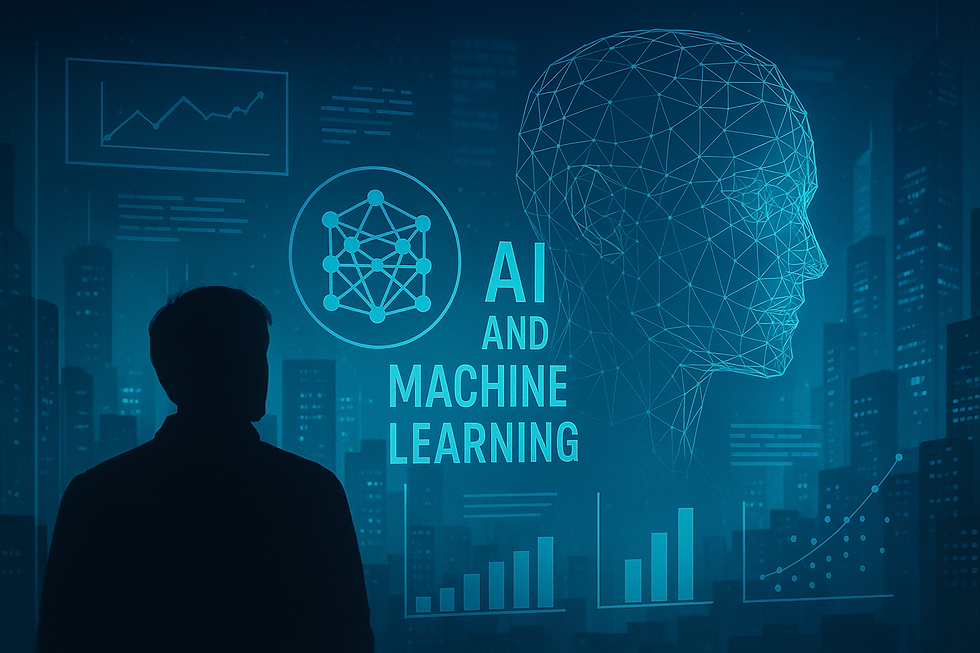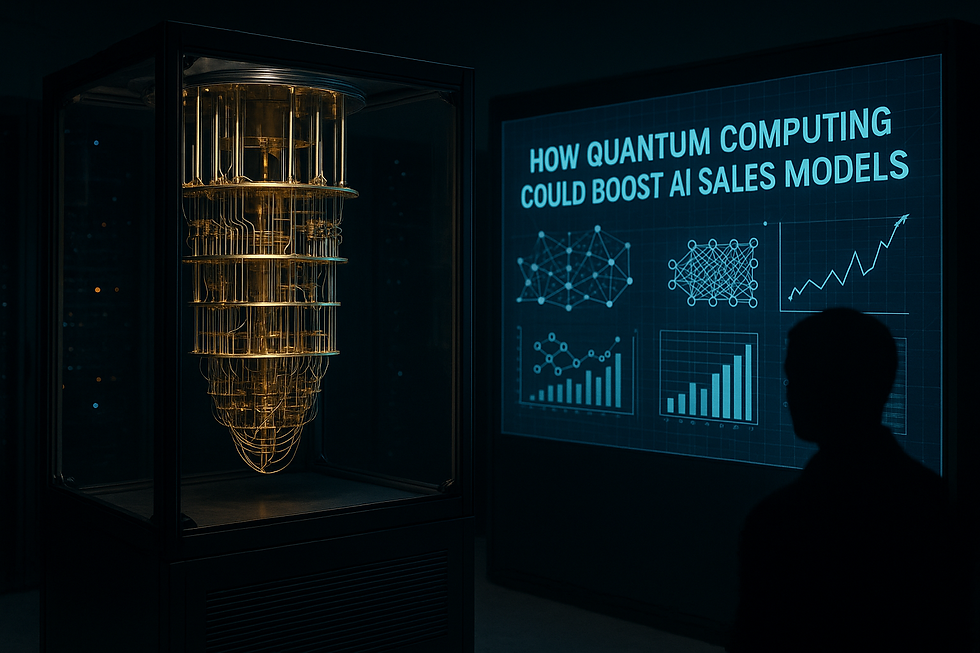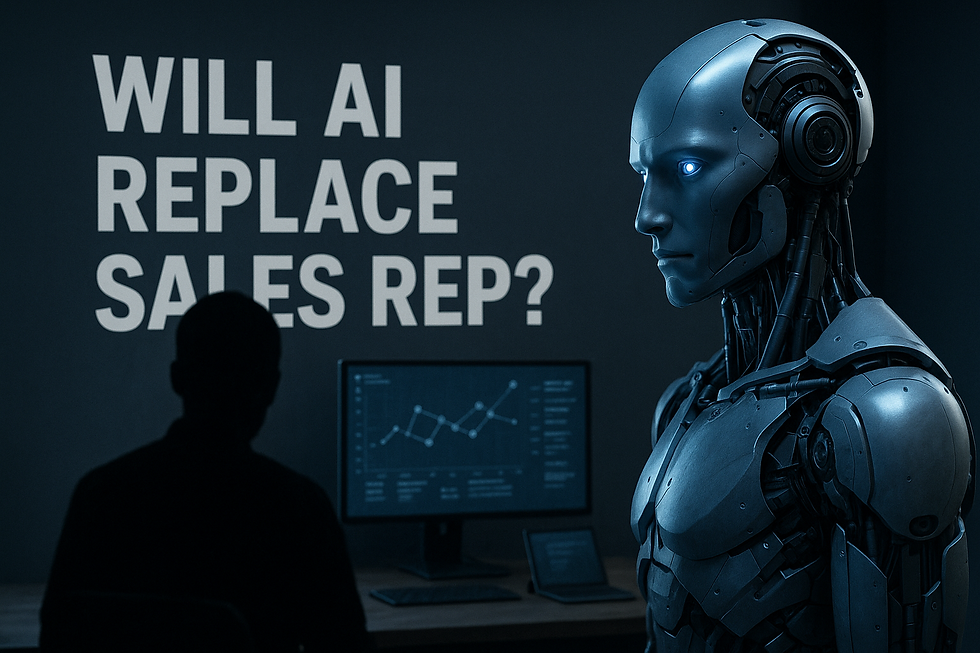What is the Future of AI and Machine Learning
- Muiz As-Siddeeqi

- 4 days ago
- 6 min read

What is the Future of AI and Machine Learning
The Future Isn’t Next — It’s Already Happening, Quietly, Loudly, All Around Us
You know what's wild? We used to think of artificial intelligence and machine learning as “future stuff.” Sci-fi stuff. Movie stuff. But now? It's already in our hands. It's in your Spotify recommendations, your Google search results, your fraud alerts from your bank, your WhatsApp's typing predictions, and even in your job rejections from resume filters powered by AI. The future of AI and machine learning isn't something we're waiting for. It's something we’re trying to keep up with.
But the question we’ll explore here, together, is: where is this going next — and why should we even care?
We wrote this because the next 5 to 15 years are going to change everything. Your job. Your city. Your data. Your economy. And you deserve to know what’s really happening — with full truth, backed by absolute real-world data, research, and case studies.
This is not fiction. This is not hype. This is the actual, documented, human-powered truth about the future of AI and machine learning.
Let’s begin.
Bonus: Machine Learning in Sales: The Ultimate Guide to Transforming Revenue with Real-Time Intelligence
Beyond Algorithms: The Real Evolution of Machine Learning
Machine learning (ML) used to be about making algorithms better at classifying spam emails or recognizing cats in images. But now, it's growing up.
1. Self-Supervised Learning Will Eclipse Supervised Models
Supervised learning relies heavily on labeled data — and that's expensive. Companies like OpenAI, Meta, and Google are now investing deeply into self-supervised learning (SSL) where models learn from raw data without needing labeled examples.
Real Example: Facebook’s SSL model “SEER” was trained on 1 billion Instagram images — completely unlabeled — and performed better than many supervised models on standard benchmarks (Meta AI Research, 2021).
Why It Matters: The ability to learn from unlabeled data will unlock training from real-world, messy, human-created content. It’ll power next-gen personal assistants, advanced enterprise automation, and language understanding.
The Convergence of AI and Real-World Interfaces
We’re seeing AI evolve from software-only to real-world embedded.
2. AI + Robotics = Real-World Autonomy
AI-driven robots are no longer confined to factories. Warehouse robots from Boston Dynamics, Amazon Robotics, and Fetch Robotics are already doing picking, sorting, and stocking.
Stat: Amazon reported in 2023 that it had deployed over 750,000 mobile robots across its fulfillment centers globally, working alongside human workers (Amazon Annual Report, 2023).
Trend to Watch: Tesla’s Optimus robot is being trialed for basic factory tasks (Tesla Investor Day, 2023), marking a shift in general-purpose robotics guided by AI.
Machine Learning Will Go Quantum — And That Changes Everything
Let’s pause here and really think about what happens when quantum computing intersects with ML.
3. Quantum Machine Learning (QML) — It’s Not a Gimmick Anymore
Case Study: In 2022, IBM and MIT collaborated on using a 127-qubit quantum processor (IBM Eagle) to simulate real-world ML problems with reduced training times. By 2025, IBM aims to scale to 4,000 qubits.
What’s Coming: QML is expected to be a game-changer for optimization-heavy tasks in finance, logistics, and drug discovery. It could dramatically reduce the time and cost of model training.
AI Is Eating The Enterprise, One Workflow at a Time
The enterprise software market is undergoing a revolution — not disruption, replacement.
4. Enterprise AI Models Will Be Personalized Per Company
Forget SaaS tools with fixed rules. Tomorrow’s enterprise AI will train models on your company’s internal data.
Case Study: Salesforce Einstein GPT, launched in 2023, allows companies to connect their proprietary data (like sales calls, CRM, emails) to create company-specific GPT models — blending LLM power with internal logic (Salesforce, 2023 Investor Briefing).
What This Means: AI models won’t just help companies — they’ll start becoming embedded in their decision-making DNA.
The “Intelligence Supply Chain” Will Be as Critical as the Oil Supply Chain Once Was
Yes, really.
5. AI Model Supply Chains Will Create Geopolitical Tensions
Access to compute, data, and chips is now becoming a global power struggle.
Fact: The US restricted AI chip exports to China in 2023, citing national security threats, cutting China off from Nvidia’s A100 and H100 chips (Reuters, October 2023).
Stat: TSMC in Taiwan produces over 90% of the world’s advanced semiconductor chips (BBC, 2023). If this supply chain is disrupted, entire AI ecosystems could collapse.
Why It’s a Big Deal: AI won’t just be a tech sector concern. It’s becoming a matter of national survival and economic sovereignty.
Machine Learning Is Going Beyond Prediction — It’s Starting to Think Strategically
We're entering a stage where ML will no longer just analyze data — it will start planning, deciding, and adapting in unstructured environments.
6. Strategic AI in Gaming, Defense, and Real-World Planning
Case Study: DeepMind’s AlphaStar (2020) was the first AI to beat 99.8% of ranked players in StarCraft II — a game requiring long-term planning, deception, and adaptation. Since then, DeepMind’s research in multi-agent RL (reinforcement learning) has expanded into logistics and air traffic control.
Real Use: The Pentagon’s Project Maven and Shield AI’s Hivemind have already deployed AI models for tactical planning in drone missions (Department of Defense, 2023 Report).
This means AI isn’t just about predicting outcomes anymore — it’s about crafting strategies.
The Next Billion People to Use AI Will Not Be Tech-Savvy
7. AI Interfaces Will Speak Your Language (Literally and Emotionally)
Stat: According to a 2024 report by Stanford HAI, only 18% of the world’s population has direct access to AI tools in their native language.
But that’s changing.
Case Study: Google’s PaLM 2 model (2023) supports over 100 languages and is being integrated into Android smartphones in developing countries (Google I/O, 2023).
Implication: AI will be used by farmers in Tamil Nadu for crop predictions, by shopkeepers in Kenya for inventory planning, and by nurses in Brazil for patient triaging — all via mobile phones, in their mother tongue, with voice, not keyboard.
Generative AI Will Transform More Than Content — It Will Reshape Creativity and Knowledge Work
Everyone knows ChatGPT and Midjourney. But this is only the beginning.
8. GenAI Will Enter Scientific Discovery, Patent Drafting, Legal Structuring
Case Study: In 2023, researchers at ETH Zurich used generative AI models to discover 30 new antibiotic molecules by simulating protein-ligand bindings and generating new molecular structures.
Stat: According to McKinsey’s 2023 GenAI report, legal firms using GPT-like tools reported a 30% decrease in contract drafting time (McKinsey, November 2023).
The future isn’t about AI making blogs or pictures. It’s about helping chemists discover, doctors diagnose, and lawyers draft at never-before speeds.
Hyper-Personalization at Scale: The Gold Rush of AI in Sales and Marketing
Yes — your field. Your business. Your blog. Your future.
9. AI Will Know Your Buyer Better Than You Do
Stat: 76% of marketing leaders reported using AI to personalize content by Q1 2024 (Statista, 2024). Meanwhile, companies like Twilio Segment, HubSpot, and Adobe Sensei are feeding ML models with behavioral and intent data in real time.
Case Study: Coca-Cola's “Y3000” product (launched 2023) was co-created using AI that analyzed global flavor trends and customer behavior. Yes — an AI-created beverage, now sold in over 20 countries (Coca-Cola, 2023 press release).
The ML models of tomorrow won’t just track customers. They’ll co-create with them.
The Rise of Responsible AI: No Longer Optional
The last few years taught us something painful — bias in AI can destroy lives.
10. Ethics, Regulation, and Transparency Will Define Market Trust
Stat: In 2023, the EU passed the world’s first AI Act, categorizing AI use cases by risk and mandating documentation and human oversight for high-risk systems (European Parliament, December 2023).
Case Study: In 2020, the UK’s algorithm for school grading led to a nationwide uproar after it systematically downgraded students from underprivileged backgrounds. The algorithm was eventually scrapped.
What’s Next: Companies will need “AI auditors” and “explainability officers.” Tools like IBM’s AI FactSheets and Google’s Model Cards are becoming standard practices.
The future of AI won’t just be about capability — it will be about accountability.
This Is Not Just the Future of Tech — It’s the Future of Power, Equity, and Humanity
We didn’t write this blog because AI is cool. We wrote it because AI is shifting the roots of power in our societies.
Those who build and control AI tools will shape what gets seen, what gets sold, what gets learned, and what gets done. This is not about jobs only. It’s about who gets to define truth, influence minds, and govern systems.
So when we talk about the future of AI and machine learning, we’re really talking about the future of humans.
Final Words (Not the End — Just the Beginning)
We won’t lie — writing this blog shook us. Because every stat, every case study, every breakthrough wasn’t just fascinating. It was a wake-up call.
Machine learning and AI are no longer tools. They’re becoming actors, collaborators, and soon maybe, partners in how we live, work, sell, buy, and think.
If you're in business, if you’re in sales, if you're in policy, or just a human trying to build a future — you need to stay aware, stay responsible, and stay deeply human.
Because the future of AI is already here.
And it’s watching. Learning. Adapting.
And yes — it’s just getting started.






Comments